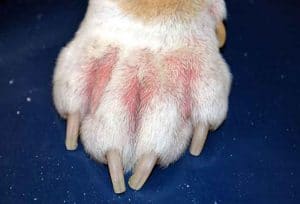How to treat dog skin allergies? Nowadays people who buy a dog are actually aware of what is in store for them. It is not only necessary to ensure optimal nutrition. The dog also books enough exercise, petting, and should go to the vet for regular checks and vaccinations at certain intervals.
However, only a few dog lovers think that a dog can get chronic diseases or develop allergies. But dog allergies are also widespread and must be specially treated by dog owners. In this article, you will find a lot of important and interesting information about the different dog allergies and what you can do about them.
When a dog develops an allergy, it is usually an overreaction of his immune system to a certain substance, and these are usually harmless substances. Unfortunately, it can also be observed in dogs and the animal world in general that allergies continue to increase and more and more dogs are affected. Experts think that this is since the environment is being polluted more and more and the fact that the immune system of the animals no longer has to work enough due to the very good hygienic conditions.
Dog skin allergy symptoms

When a dog has an allergic reaction, the allergy usually manifests itself in the form of itching. This itching occurs particularly on the head and on the paws of the animals, but can also be observed in the armpits and the stomach area. A dog that suffers from itching will respond by licking and scratching. Unfortunately, because of this, infections quickly occur, which are associated with bacterial pathogens or even yeasts.
Another sign of an allergy is an inflammation of the ears, which you as a dog owner often cannot see from the outside. In this case, too, your darling scratches their ears more and more, so you should have a doctor checked. Furthermore, many dogs react with digestive problems, which could be attributed to an allergy to the dog food. This is where flatulence and diarrhea occur particularly often.
The causes of the dog skin allergies and how to treat?
Many different factors play an important role in identifying the cause of an allergy. For example, it is not uncommon for the predisposition to develop an allergy to be genetically determined and thus passed on from the parent animals. So if the dog’s parent animals suffer from allergies, the dog owner should expect that your dog could develop an allergy over time. But not only the genes can be the cause of the allergy. Individual exposure to various environmental toxins can also be to blame. Additionally, too much stress can cause your dog to develop an allergy.
Types of Allergies in Dogs

In dogs, the various allergies are divided into the three most common forms. These are triggered by various causes, which are also known as allergens.
We will introduce you to the following allergies:
Atopy allergy in dogs
Atopy, also known as atopic dermatitis, is one of the most common allergies in dogs. With this allergy, the dogs react to mold, feed mites, or house dust as well as various pollen from grass or trees. This allergy is accompanied by severe itching. However, the individual causes are not inhaled by the dog. They come directly over the animal’s skin. Atopy usually develops quite early and often appears from the age of one year. Sometimes later, but this only happens in rare cases.
Dog food allergy
Many dogs are also allergic to their food. This allergy is more common than dog owners would like it because the symptoms are very different. This leads to flatulence, which is not necessarily associated with intolerance. Vomiting and diarrhea are also among the first signs that indicate a feed intolerance. In this allergy, the allergens get into your dog’s body through food. These allergies can occur even in small puppies. There are many different triggers. The most common triggers, however, are beef, wheat, and chicken or various dairy products, including lactose.
The flea bite allergy

This allergy is rarer than the two cases already presented. This is an allergy in which the affected dog reacts to the saliva of fleas. A single flea bite leads to severe itching. While the main points of the other allergies are mostly to be found on the head or the stomach, in the case of flea bite allergies these are mostly to be found on the croup or back of the animal.
Important: allergies cannot be cured. This is because these predispositions to be allergic to different things or substances are predisposed and unfortunately persist for a lifetime. If an allergy is to be treated, it is only possible to get the symptoms under control as much as possible, but they cannot be eliminated. Such therapy can be very tedious but should be attempted when the owner is able.
How to treat dog skin allergies naturally?
Before starting any special treatment, the veterinarian must first rule out other causes, such as a parasite or fungal attack, and then examine the animal. Bacterial infections must also be 100 percent ruled out in advance. Now the allergens causing the allergy must be identified. There are various tests for this.
The allergy test for flea saliva allergy and atopy
During this test, some blood is drawn from the dog. This blood test can be used to determine whether the dog is reacting to fleas, mites, pollen, or mold. After the blood is drawn, it is sent to a special laboratory, where it is then tested for the various allergens. The result is available within just a few days.
The Elimination Diet
This special diet is carried out in the case of food allergies and is used to find out which components the dog is now allergic to. With this special diet, the affected dog is initially given a single source of protein in the food for eight weeks, i.e. a type of meat and a source of carbohydrates. It is best if owners choose things that are as new as possible to the dog. This means that it shouldn’t be in the normal feed from before. The rare and exotic sources of protein, such as horse meat, deer, or ostrich, are particularly suitable for this. Potatoes or tapioca can be used as a source of carbohydrates. Due to the special composition, it is also possible to prepare the food yourself.
If the itching is gone after eight weeks, you as the owner can be sure that your dog is not allergic to any of these components. It is now possible to mix in other components. Again for eight weeks. This allows you to gradually expand the feed. As soon as itching occurs, the component must of course be removed again.
In this type of allergy test, the elimination must always be carried out for at least eight weeks. During this time, it is very important that you and anyone else who comes into contact with your dog stick to this plan. Even the smallest change, such as giving a treat with an ingredient that your dog cannot tolerate, can greatly falsify the result and ruin the previous work.
Further steps in case of allergies
Once it has been determined what the dog is allergic to, these things should be avoided. This is easiest with a feed allergy. This can also be avoided in the case of flea saliva allergy by taking regular flea prophylaxis. If it is an allergy to pollen or house dust mites, avoiding contact is of course much more difficult.
However, if contact with allergens is difficult or even impossible to avoid, there is also so-called desensitization, which is also known as antigen-specific immunotherapy. With this therapy, too, an allergy test is carried out in advance to find out exactly what the affected dog is allergic to. A special laboratory can now develop a solution from this allergen, which is injected into the dog over at least one year.
Injection for allergies (dog skin allergies treatment)
Injection always starts weekly. However, distances are then increased. With these regular injections, the dog’s immune system gets used to the allergens. This has the consequence that the symptoms of the allergy decrease. If this method works, it is important not to simply stop injecting. These must be continued for a lifetime, as the allergy cannot be completely cured, only the symptoms can be alleviated.
If the symptoms are very severe, treatment with cortisone is also possible. The cortisone can reduce the functions of the dog’s immune system so that the overreaction to the corresponding allergen is also reduced. With this therapy, however, the disadvantage arises that the immune system is weakened overall and the defense against other pathogens is also reduced. For this reason, this treatment must always be carefully considered. As soon as cortisone therapy lasts longer, other side effects affect the dog’s complete cycle.
Those who want to avoid the negative side effects of cortisone can resort to antihistamine therapy. Such an application does not weaken the entire immune system, but only the histamine-mediated reactions. Unfortunately, this therapy is not nearly as effective.
Conclusion
How to treat dog skin allergies? As soon as you even feel that your dog has an allergy, you should have it checked with your veterinarian. This is the only way you can relieve your dog of the already exhausting and complicated allergy and alleviate the symptoms. Make sure, however, that your vet takes your doubts seriously, and don’t let yourself be shaken off, but insist on as many tests until you find the problem. This is the only way to make positive changes to your dog’s everyday life.
Our previous article How to give bath to a puppy? An expert guide for you! We recommend that you read our article titled.






